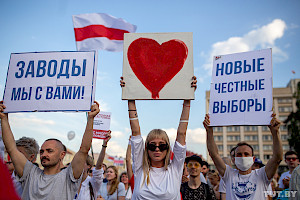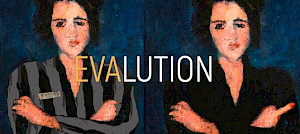For a Belarusian res publica!
Zur deutschen Fassung des Textes
The nationalist opposition in Belarus has been marginalized, argues Coordinating Council member Olga Shparaga in interview with ‘Osteuropa’. National heroes and vertical power structures no longer have popular appeal. The focus of the new oppositional discourse is instead on peaceful cooperation, social inclusion and the soft power of women.
Osteuropa: One of the campaign slogans of the movement against the Lukashenka regime is Žyve Belarus! – Long live Belarus! Is this a national revolution?
Olga Shparaga: A revolution is indeed taking place in Belarus. But it is a post-national revolution. The key concepts of the protests are ‘constitution’ and ‘law’, not ‘nation’. It is about the removal of a dictatorial regime. People are fighting for respect for the law, for free elections, and for the possibility for a change of government. It’s about Belarus becoming a republic not just in name, but as a res publica in the tradition of the French Revolution. It is a democratic revolution in which subjects are becoming citizens.
The opposition coalition declared that this revolution is being carried out ‘by all of us together’, in other words from a horizontally networked society. There is practically no mention of the past. Constant reference to history, to heroes and myths is precisely what defines a national community. The fact that women – or, to be precise, a collective of women – have been at the head of the revolution also runs counter to the nationalist discourse, in which the role of women is to take care of the reproduction of the nation, by giving birth to and raising children. Women have no place in politics according to this view of things. It is no coincidence that Chaim Soutine’s painting ‘Eva’ has become the symbol of the revolution. Soutine was a Jew born in what is now Belarus. That too contradicts the nationalist idea of a homogeneous, mono-ethnic nation.
What about the ubiquitous red and white flag of the short-lived Belarusian Republic of 1918, a symbol of the national opposition for the past two and half decades?
The flag and the slogan Žyve Belarus! are merely substitutes for official symbols. They unite people without obscuring the differences between them. Some speak Russian, others Belarusian. The song ‘Mury’ (Walls), the Solidarity anthem by the Polish singer Jacek Kaczmarski and the hymn of the revolution, is sung in both languages. The other hymn of the revolution is ‘Peremen’ (Change) by Russian rock star Viktor Tsoi, from the Perestroika era. This doesn’t contradict the slogan Žyve Belarus! at all.
After the brutality of the authorities immediately after the election, both the slogan the flag have taken on a new meaning, one that was always inherent in them. They stand for spilled blood and the fight against death. The colour white was also used for the ‘armbands of honesty’ that people wore on election day. After 12 August, women protesting against the police violence wore white as a sign of solidarity. The use of the colour white was not because of the flag, it was more the case that the flag matched the colour white.
Is this interpretation unanimous?
Of course, there are groupings within the opposition who see it as a national revolution, who believe that Belarus has finally formed itself as a nation. They include those who have formed around the movement ‘For freedom’ (‘За свабоду!’) or around the Belarusian Christian Democrats. They are visible above all thanks to Olga Kavalkova, who represents Sviatlana Tsikhanouskaya in the Coordinating Committee. But when one asks more closely what kind of nation it is, then immediately a whole series of definitions arise. For example, there is the rightwing-conservative version of Zianon Pazniak [the archaeologist responsible for revealing the NKVD mass graves in Kurapaty and a co-founder of the Belarusian Popular Front in the late 1980s –ed.]. Then there is the centrist, intellectual nationalism around the magazine and publishing house Arche, whose focus is primarily historical. And there is the ‘pop’ nationalism of symbal.by, a cultural initiative and business. There is no common national idea, rather a polyphony of ideas – and no one, or at least very few people, seems to mind. Despite what nationalists claim, there is no clash of cultures. Anti-Russianism is constitutive of almost all forms of Belarusian nationalism. But because there is very little opposition to Russia in this revolution, the national question has remained marginal.
Of course, the white and red flag was the symbol of the Belarusian People’s Republic. But today very few people talk about this. They aren’t looking for heroic images from the past. Instead, they are oriented towards peaceful cooperation (rather than competition), horizontal structures (rather than the vertical structures of elitist nationalism), and on the ‘soft power’ of women (rather than armed men on horses). As I see it, the protests are about new strategies of social inclusion, and about how to organise in a democratic way so that different people and groups are recognized, rather than their differences being negated.
The protests have been taking place across the whole country. Are they the same everywhere? Or are local concerns playing a role?
The regionalization of the protests is a new phenomenon. During the election campaign, Tsikhanouskaya and her team talked to citizens in every city about their concrete problems – in Brest, for example, about the campaign against the construction of a battery factory. However common topics have dominated the protests: the lack of perspectives, poverty and corruption; and the contempt with which the state treated its citizens during the COVID-19 pandemic; the exodus of the youth, the prevention of a change of government, and the now customary falsification of election results.
You have argued elsewhere that the authoritarian repressions in Hungary, Poland and the US are a result of a return of social unrest. Is the situation different in Belarus?
People in Belarus have had enough of the authoritarian, paternalistic and repressive state. The regime has always claimed that Belarus is the only country in the region with a strong welfare state. That may have been the case to some extent in the past, however over the years the welfare state has eroded. Studies carried by the Belarusian research institute IPM have shown this clearly.
The pandemic made the situation worse. It revealed that the entire administration operates ineffectively and that the state and its officials look down on the people. And so people began to help one another. Voluntary work was of huge importance. But state media remained silent about it, at the same time covering up the fact that infection and death rates were going up. This has caused many people in Belarus to see the fight against the state as the most important task.
However, criticism of authoritarianism is often accompanied by the idea that we also need to free ourselves from the welfare state as such. A significant part of the ‘old opposition’ believes this. The idea of the minimal state is very widespread in oppositional circles. The United Civic Party of Belarus, for example, has advocated this idea ever since the mid-1990s. Today, the party has a youth wing called the ‘Young Democrats’ that identifies as libertarian.
The ‘old opposition’ emerged in reaction to Soviet state socialism and under the influence of neoliberal thinking. Its members separate political rights from social rights and see the market as the sole mechanism for guaranteeing social justice. Nationalism in Belarus makes no distinction between Soviet state socialism and Nordic social democracy, for example. Because cultural identity and history have always been foremost for nationalists, there was never any space for economic questions. Socialism was the problem and the free market was the solution – full stop. Equality was seen as a Soviet relic and rights for women, LGBT people, the elderly or people with disabilities were associated with that.
And what does the ‘new opposition’ think?
Many social organizations have emerged in the past decade for whom inclusion and social rights are key concepts. Examples are the human rights organisation Human Constanta, the campaign ‘March, baby!’, which fights for legislation against domestic violence, the project Belarus Active Youth, the Kryly Khalopa theatre in Brest, and many more. They believe that social rights are a component of political rights. All these organizations are related to initiatives that criticize the neoliberal agenda beyond Belarus. They will hopefully play an important role in the necessary political and economic transformation, so that it does not proceed according to the neoliberal plan.
Extended English version of the German version, translated by Simon Garnett




